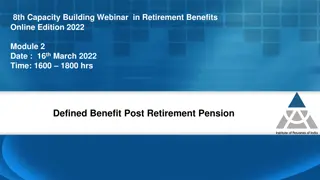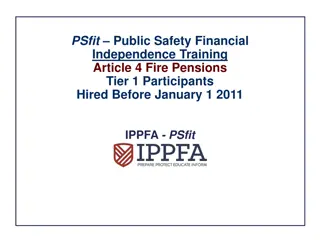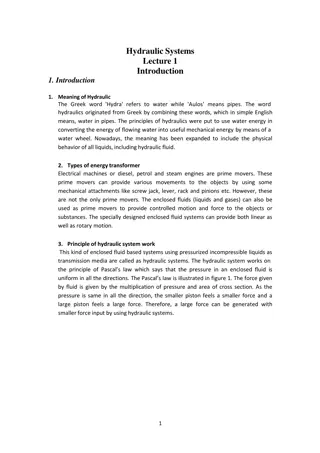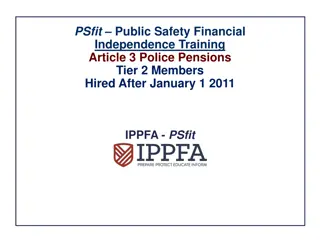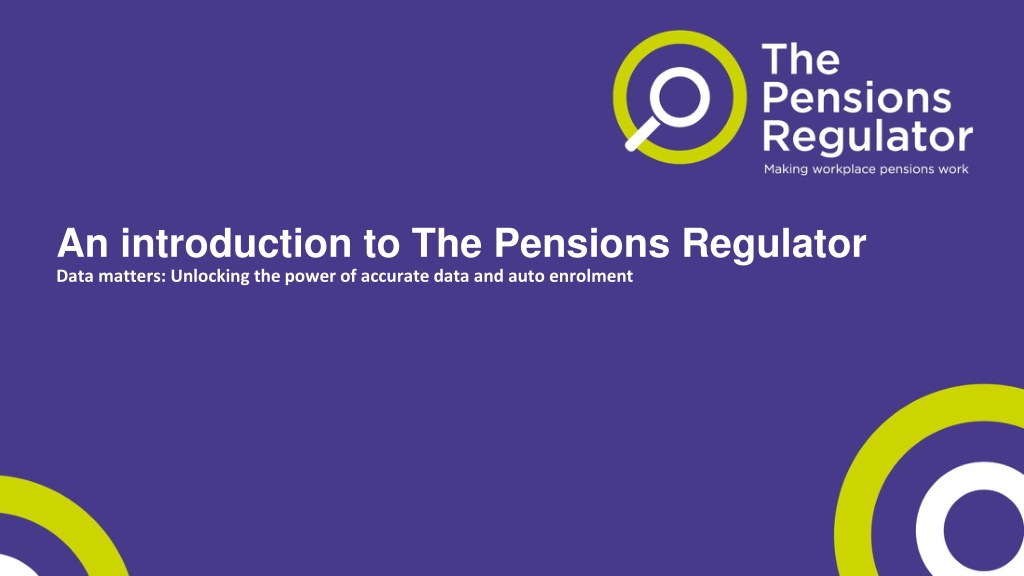
Unleashing the Power of Pensions Regulation Data
Explore the vital role of The Pensions Regulator, responsible for ensuring proper pension schemes, safeguarding savings, and promoting effective pension management. Learn about TPR's priorities, corporate strategy, and collaborative efforts in the pension sector.
Download Presentation

Please find below an Image/Link to download the presentation.
The content on the website is provided AS IS for your information and personal use only. It may not be sold, licensed, or shared on other websites without obtaining consent from the author. If you encounter any issues during the download, it is possible that the publisher has removed the file from their server.
You are allowed to download the files provided on this website for personal or commercial use, subject to the condition that they are used lawfully. All files are the property of their respective owners.
The content on the website is provided AS IS for your information and personal use only. It may not be sold, licensed, or shared on other websites without obtaining consent from the author.
E N D
Presentation Transcript
An introduction to The Pensions Regulator Data matters: Unlocking the power of accurate data and auto enrolment
Session overview The role of the Pensions Regulator (TPR) TPR s role in respect of public service pensions Automatic enrolment Pension dashboards Opportunity for questions 2 These slides remain the property of The Pensions Regulator and their content should not be altered on reproduction.
TPR what is our role? We are responsible for: making sure employers put their staff into a pension scheme and pay money into it (known as automatic enrolment ) protecting people s savings in workplace pensions improving the way that workplace pension schemes are run reducing the risk of pension schemes ending up in the Pension Protection Fund (PPF) making sure employers balance the needs of their defined benefit pension scheme with growing their business 3 These slides remain the property of The Pensions Regulator and their content should not be altered on reproduction.
TPRs priorities We are a public body sponsored by the Department for Work and Pensions (DWP), based primarily in Brighton and have around 950 staff We work closely with the Financial Conduct Authority (FCA) who regulate personal pension schemes. We also work closely with other public bodies including the DWP, PPF and Money and Pensions Service Our board members oversee what we do and make sure that TPR is well run Together with the FCA, the Financial Ombudsman Service, the Financial Services Compensation Scheme and the Money and Pensions Service, we have produced the Wider Implications Framework, a formal agreement for closer working on financial issues. 4 These slides remain the property of The Pensions Regulator and their content should not be altered on reproduction.
TPRs priorities In our Corporate Strategy, there are five high-level priorities, each with a strategic goal, which indicate our core areas of focus: Security: Savers money is secure Value for money: Savers get good value for their money Scrutiny of decision-making: Decisions made on behalf of savers are in their best interests Embracing innovation: The market innovates to meet savers needs Bold and effective regulation: TPR is a bold and effective regulator. The detail behind our day-to-day work is set out in our Corporate Plan 5 These slides remain the property of The Pensions Regulator and their content should not be altered on reproduction.
Supervision One-to-one supervision is part of our evolving approach to protecting and regulating pensions In addition to the process for authorisation and supervision of authorised master trusts, supervision is in pace for other workplace DB and DC schemes in both the public and private sectors It involves pro-active engagement with trustees, employers, scheme managers and other stakeholders to protect the interests of members Relationship building Making better use of our data Intelligence led reactive engagement to specific events Clearer, quicker, tougher interventions 6 These slides remain the property of The Pensions Regulator and their content should not be altered on reproduction.
Enforcement Carry out an investigations into breaches of law, non-compliance or other issues Investigate regulatory, civil and criminal matters Work closely with other organisations including the Insolvency Service, Serious Fraud Office and various police forces Our regulatory powers include: Collection of data, obtain information, conduct inspections Imposition of civil penalties and criminal prosecution Issuing of improvement notices and third-party notices Other interventions, such as requiring a skilled person s report, appointment of a person to assist the pension board, recovery of unpaid contributions from employers on behalf of the scheme manager Ability to publish reports about cases regarding our regulatory work 7 These slides remain the property of The Pensions Regulator and their content should not be altered on reproduction.
TPR and Public Service Pension Schemes We regulate compliance with the Governance and Administration requirements introduced by the Public Service Pensions Act 2013 We provide details of our expectations in codes and guidance We engage mainly with scheme managers and pension boards to oversee and monitor compliance with the requirements We have the power to take regulatory enforcement action, by way of improvement notices, third party notices and fines, in cases of non-compliance 8 These slides remain the property of The Pensions Regulator and their content should not be altered on reproduction.
PSPS Responsibilities Scheme Managers: Scheme regulations / rules requirements Awareness of employer admission agreements Clear, robust, published processes / deadlines / communications Designated scheme contact point Understand material breach of law reporting requirements, follow through on non-compliance Employers: Requirement to provide information requested Awareness of terms of employer admission agreements & requirements of regulations Compliance with contract terms and obligations under regulations Manage HR / payroll systems, including monitoring data quality, joiners, leavers and turnover 9
Examples of PSPS intervention (1) Teachers Pension Scheme Breach of law reports received, 43 employers failing to submit their End of Year Certificates by the required deadline. Scheme intervention had failed, so TPR engaged with employers identifying lack of knowledge and understanding of their role, remedied with only one failure (since removed from the scheme) Scottish Teachers Pension Scheme Breach of law report from scheme, simultaneous voluntary plan for resolution. TPR were concerned that whilst plan was feasible, it would take too long, so issued an Improvement Notice. Ongoing close engagement during the period of the Notice meant further enforcement against scheme / employers was not required 10 These slides remain the property of The Pensions Regulator and their content should not be altered on reproduction.
Examples of PSPS intervention (2) London Borough of Barnet Fine of 1,000 issued against scheme manager for failing to submit its annual scheme return, following a failure to engage with TPR and a reference to our Determinations Panel following which a Penalty Notice was issued Oxfordshire LGPS No Annual Benefit Statements issued, due to poor data, in part due to the fund s employers. TPR worked with them to create a data improvement plan, which also addressed wider governance and administration of the fund. Concerns remained, though, so a Warning Notice and subsequently an Improvement Notice was issued These slides remain the property of The Pensions Regulator and their content should not be altered on reproduction.
Automatic enrolment, setting the scene 12 These slides remain the property of The Pensions Regulator and their content should not be altered on reproduction.
Automatic Enrolment, now Someone is eligible for AE if they are aged between 22 and State Pension Age (SPA) and have earnings above the earnings trigger (currently 10,000pa) Minimum contributions are calculated on qualifying earnings between a lower threshold (currently 6,240pa) and an upper threshold (currently 50,270pa) Someone aged between 16 and 74 with earnings at or less than 10,000 but above 6,240 can opt in and the employer must contribute to their pension scheme Someone aged between 16 and 74 but with earnings less 6,240 can join but the employer does not have to contribute to their pension scheme. 13 These slides remain the property of The Pensions Regulator and their content should not be altered on reproduction.
Eligible employee participation 14 These slides remain the property of The Pensions Regulator and their content should not be altered on reproduction.
Automatic enrolment, the future? AE 2017 Review changes ( AE Expansion ) Someone will be eligible for AE if they are aged between 18 and SPA (and have earnings above the earnings trigger). Minimum contributions will be calculated on qualifying earnings from 0.01 up to the upper threshold ) ie contributions calculated on earnings from 0.01 up to 50,270 Anyone aged between 16 and 74 with earnings at or below the earnings trigger can opt in and the employer must contribute to their pension scheme Timetable is a matter for government but we stand ready to support employers and advisers with implementing them once known 15 These slides remain the property of The Pensions Regulator and their content should not be altered on reproduction.
Automatic enrolment powers Power January to June 2024 Information notice 64 Inspection 100 Warrant 0 Compliance notice 30,688 Unpaid contributions notice 18,589 Fixed penalty notice 20,677 Escalating penalty notice 7,682 Production order 0 Total 77,800 16 These slides remain the property of The Pensions Regulator and their content should not be altered on reproduction.
Pensions Dashboards - Strategic context As a result of automatic enrolment, more people than ever are now saving for their retirement In addition, a change in people's working patterns over the past few decades means savers can build up multiple pension pots which can be difficult to track Pensions dashboards aim to reconnect savers with their pension savings (an estimated 2.8m lost pots*) and ensure they have a comprehensive view of their pensions Pensions dashboards support TPR's strategic outcomes that aligned to our long-term strategic outcomes that savers are able to better interact with their savings, and can access good advice and guidance *PPI Lost Pensions Survey 2022 These slides remain the property of The Pensions Regulator and their content should not be altered on reproduction.
Pensions dashboards how they will work The dashboard digital architecture will verify the individual s identify and obtain their consent to complete a search Individuals will make a request to find their pensions, then once they ve received a confirmed match, they can request to view more detailed data about their pension. All pensions information for the individual can be seen side by side on the dashboard, including information about expected income in retirement.
Getting data dashboard ready: four key steps 3 2 4 1 Put plan in place Improve the data quality Maintain the data quality Assess Consider Data items for matching criteria How to present and calculate the value Understand Data you will receive from the digital architecture Data you will need to return to members and by when Current quality Digital accessibility 19














